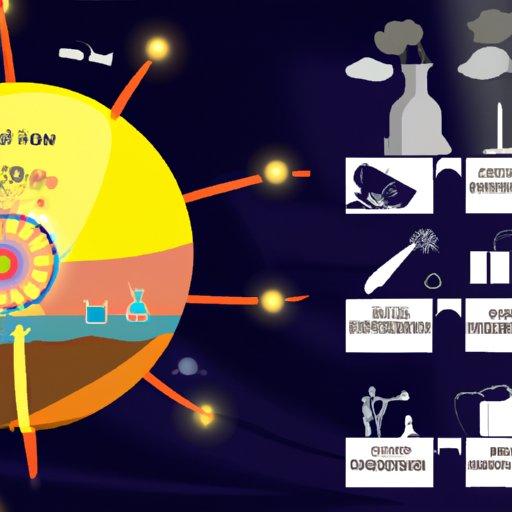Introduction
The invention of the nuclear bomb was a watershed moment in human history, with profound implications for international relations and global security. While the atomic bomb is commonly associated with the end of World War II, its invention and development began long before the conflict. This article explores the historical timeline of the nuclear bomb, the scientists behind its invention, and the impact it had on the course of World War II.

Historical Timeline of Nuclear Weapon Invention and Development
The invention of the nuclear bomb was a process that spanned a number of decades and involved contributions from numerous scientists and engineers. At the beginning of the 20th century, scientists began researching and theorizing about the potential for harnessing atomic energy. By 1938, German chemists Otto Hahn and Fritz Strassmann discovered nuclear fission, the process by which an atom splits and releases energy. This discovery marked a major breakthrough in understanding the potential of atomic energy.
In response to the threat of Nazi Germany obtaining nuclear weapons, the U.S. government launched the Manhattan Project in 1942. This top-secret project was led by physicist J. Robert Oppenheimer and tasked with developing the first atomic bomb. After three years of intense research and development, the first successful test of a nuclear weapon took place in Alamogordo, New Mexico, on July 16, 1945.

Exploring the Impact of the Atomic Bomb on World War II
The detonation of the first nuclear bomb marked the beginning of a new era in warfare. On August 6, 1945, the United States dropped an atomic bomb on Hiroshima, Japan, killing tens of thousands of people and devastating the city. Three days later, another atomic bomb was dropped on Nagasaki. The destruction caused by these bombs forced Japan to surrender, bringing an end to World War II.
The use of atomic bombs ushered in a new era of fear and uncertainty. The Soviet Union soon began working on its own nuclear weapons program, leading to a post-war nuclear arms race between the two superpowers. This race would become a defining feature of the Cold War, as both sides sought to gain a strategic advantage through their nuclear arsenals.
The Scientists Behind the Creation of the Nuclear Bomb
The invention of the nuclear bomb would not have been possible without the contributions of several key scientists. J. Robert Oppenheimer, an American physicist, was the director of the Manhattan Project and is widely considered to be the “father of the atomic bomb”. He was assisted by Italian physicist Enrico Fermi, who developed the concept of a “chain reaction” that could be used to create a nuclear explosion.
Albert Einstein, the German-born physicist, is also credited with playing a role in the development of the atomic bomb. His famous equation, E=mc2, provided the theoretical basis for understanding the release of energy from atomic fission. Although Einstein himself opposed the use of atomic weapons, his work served as the foundation for the Manhattan Project.

Understanding the Political Motivations Behind the Invention of the Nuclear Bomb
The decision to develop and use atomic weapons during World War II was driven by political considerations as much as scientific ones. President Harry Truman saw the atomic bomb as a way to bring a swift and decisive end to the war, sparing the lives of thousands of American soldiers.
Truman’s decision was also shaped by the tense relationship between the United States and the Soviet Union. With the Soviets rapidly expanding their sphere of influence in Eastern Europe, the United States wanted to maintain its strategic advantage by having access to nuclear weapons.
The Role of Nuclear Weapons in Cold War History
The invention of the nuclear bomb had far-reaching implications for international relations and security. During the Cold War, both the United States and the Soviet Union maintained large nuclear arsenals in order to deter each other from launching a nuclear attack. This strategy of “mutually assured destruction” kept tensions between the two countries in check for decades.
The proliferation of nuclear weapons has also been a major concern for international leaders. Since the end of the Cold War, several countries have acquired nuclear weapons, raising fears of a global nuclear conflict. As such, the legacy of the atomic bomb remains a source of debate and controversy.
Conclusion
The invention of the nuclear bomb is one of the most consequential events in modern history. Its invention changed the course of World War II and shaped the geopolitical landscape of the Cold War. The scientists behind the creation of the atomic bomb, including J. Robert Oppenheimer, Enrico Fermi, and Albert Einstein, played a crucial role in the development of this powerful weapon. The invention of the nuclear bomb continues to have a profound impact on global politics and security, and its legacy will remain a source of debate and discussion for years to come.
(Note: Is this article not meeting your expectations? Do you have knowledge or insights to share? Unlock new opportunities and expand your reach by joining our authors team. Click Registration to join us and share your expertise with our readers.)
